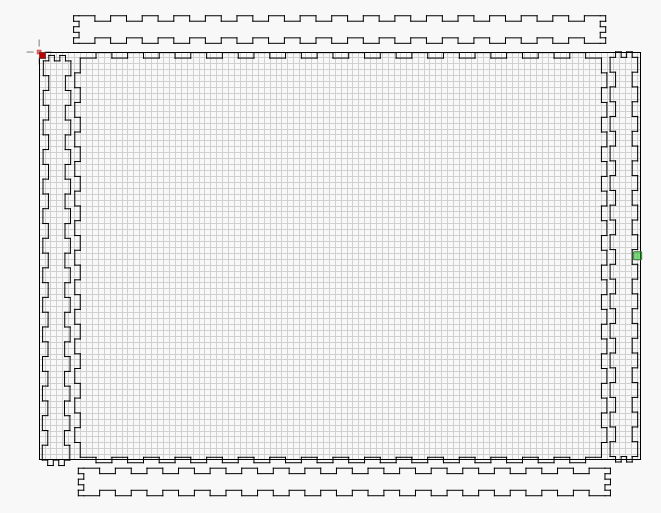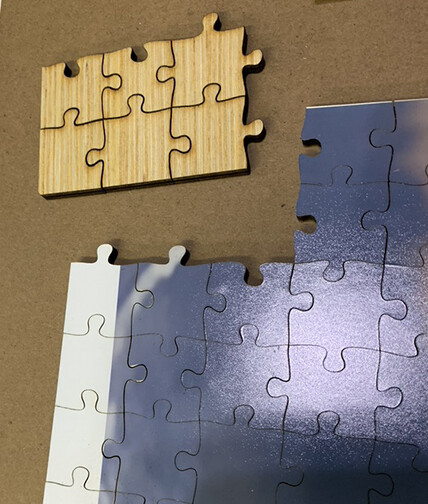I have looked in all the wrong places for sure. Will someone attempt to either guide me to the written word on using KERFS or give me a concise idea other than the fact that I know what offsets are etc. in running a CNC, so that I can use them intelligently in Lightburn?
I’ll write this in a way that it can be understood by a wider audience. Forgive me if some of the concepts are rudimentary.
The purpose of the kerf offset is to accommodate the width of the cut resulting from a laser operation. In normal operation, LightBurn will cut or fire the laser directly on the line in a given design. It makes no accommodation for laser beam width or the resulting cut width. Basically the assumption is that the laser bean is infinitely narrow.
However, the reality is that depending on many conditions including lens type, focus, material, etc. the actual kerf from a cutting operation is non-zero in size. As a result the size of a cut out object will be smaller than the actual designed size because the kerf has cut into the material’s planned dimensions.
The kerf offset function in LightBurn is designed to adjust for this phenomenon by both automatically cutting outside of the line for an outer cut and cutting inside of the line for an inner cut. Imagine a donut cutout. The cut along the outer shape is made bigger. The cut along the donut hole is made smaller. The result is a lasered object with dimensions that matches the original intended design.
The correct kerf value itself likely needs to be determined empirically as it will depend on many factors. However, once determined it should hold and be repeatable for those given factors. The value entered into LightBurn should be the full kerf width as determined.
Note that kerf offset only makes sense for closed shapes. As in this would not work on a line or other unclosed shape as inside/outside would have no meaning.
Alternatively, instead of using kerf offset, you could attempt to do this manually by applying offsets to your objects before cutting.
I think you stated you work with wood. You mark a piece of wood with lines that are 16 inches apart.
If you ‘cut the line’ the board will be ‘short’ by the blades kerf. 1/2 of the kerf is used at each end since you are cutting the line, half on the ‘scrap’ side and half on the ‘good’ side for the complete width.
The only way to get a 16 inch piece is to align the one side of the blade to cut ‘on the line’, adjusting where the cut starts to eliminating the error caused by the kerf. This done at each end, gives you a full 16 inch part.
Where is comes into play is that you can have a ‘tab’ and a ‘hole’ that are designed exactly equal in size. With no clearance, they will NOT fit. Generally I found that 1/2 kerf on each part works well.
There are some problems that you should be aware of as @berainlb noted. I commonly do something that part ends up larger than the machine can handle.
I have a stereo cover I made for a friend that is a bit larger than the laser bed.
The complete design generated by the box generator. I only want ‘joints’ at the corners to prevent it from sliding off the stereo.
For the application, I only need the four corners and they are symmetrical.
Only one corner is needed…
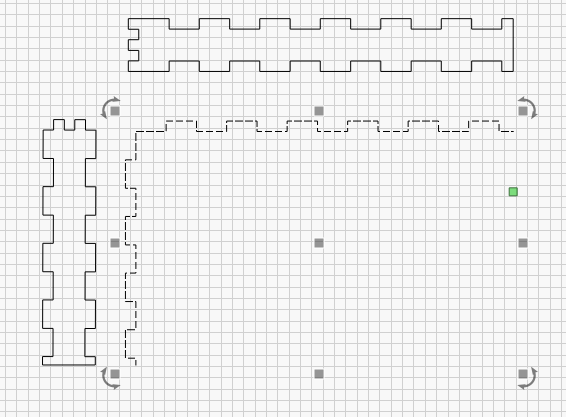
The large ‘open’ shape (selected) will not allow you to apply a kerf. I adjust the other parts to make up for the lack of ability to apply the kerf. In this case it’s not that big an issue, but if more than one part is open, it makes things difficult.
The shape has to be closed so the software knows ‘inside’ from ‘outside’. It would be nice to be able to tell it which side to apply the kerf.
When I cut it, I put it in with the front/left side of the part to the back/left and make the cut, then flip it horizontally for the right/back. Then flip it vertically for the other two ends…
Good luck…
Hope I didn’t confuse you even more… 

I obviously did not word my question/questions well, as usual.
I am well versed in Industrial CNC programming since I wrote most of the programs we used for 40 years.
I appreciate all the obviously well thought information you folks provided. I know many who haven’t had the experience I have been privileged to acquire will have a chance to read your responses and benefit.
My question was meant to address the actual affect changing the kerf width setting/settings in LB would have on the width of kerf top and bottom of my substrate.
I must apologize profusely for misleading you.
The kerf setting would make no change to the kerf itself. It only affects the location of the cutting line.
Thank you,
You folks are winners!
I understand what you are saying but…
I cut a prototype yesterday after I set the kerf to .075. The kerf between the pieces in the puzzle were much closer on the top side and about the same on the bottom or the photo side.
I think this is another problem you have, that there is a difference from top to bottom in your cutouts.
But kerfsettings for a puzzle - I do not understand either. You only move cuts from one side to the other, all the material that is evaporated during the cutting is missing in the end and nothing is added from the outside. 
In a box with a finger joint, you have separate parts which are externally cut separately and half of the kerf is distributed on each side / part.

Our main business for 40 plus years was making personalized wooden products. Most of those consisted of a child’s name cut from MDF with melamine on both flat sides. We cut the letters from one sheet of material while back that received the letters were cut from different material. The offsets in my program were identified as positive or negative. I used that ability to account for wear or a sharpened bit difference in diameter. That proved to be too expensive so I put the used bits in boxes of over a thousand and bought new hundreds at a time.
Thanks again 
I want to make sure I understand what you’re saying.
- You cut the puzzle face-side down.
- When you compare cuts made with 0 kerf vs cuts made with .075 kerf you’re saying that the resulting kerf is smaller on the top surface with the cut made at .075 kerf? And no difference at the bottom?
If so, this is definitely not what I would expect. Can you confirm that all other variables remained the same? Same FD from lens to material? Same material, same lens, same cut settings? Same air assist?
Can you confirm that the cut was made wide of the design line?
I suggest you try various cuts at a gradation of kerf sizes to see how results extrapolate. My understanding of this makes me believe this has to be an anomaly but good to prove it out.
Try this…
When the kerf is set at 0.000 the burned portion is centered on the actual line of the design, right?
Thus it takes an equal amount of material from inside and outside the line. If you set the kerf for positive as in 0.075 the laser will cut off center by that amount and the puzzle pieces will be wider making the entire puzzle somewhat larger in all directions. If I adjust the speed, power, and Focus to cut a very thin line I should have less space between pieces. Or am I trying to over symplify ?
You are just changing where it’s cutting, nothing else.
They won’t be wider, they will be offset by the kerf.
The kerf is also applied to previous puzzle piece, so there is no overall change.

Yes.
Agree.
Yes. Keeping in mind this only works if each piece is its own closed path shape. And also keeping in mind that this only works if each piece is cut separately with physical separation between parts. You won’t be able to cut a full puzzle in-place since you’d be intruding into the other puzzle pieces.
Yes. But this is true irrespective of kerf setting. Ideally you’d dial-in the settings to achieve the thinnest kerf possible. And only then use kerf offset setting to accommodate for the kerf in order to obtain a dimensionally accurate part.
Thank you,
I get it!!!
I sure do get a lot of learning done when we have lots of snow and ice
Let me see if I can get pic or two to show the kerf tomorrow plus my settings.
Thanks
… then I’m still not completely in the woods, the whole thing was just so confusing a transition that I myself begin to wonder about things that are otherwise clarified and logical. ![]()
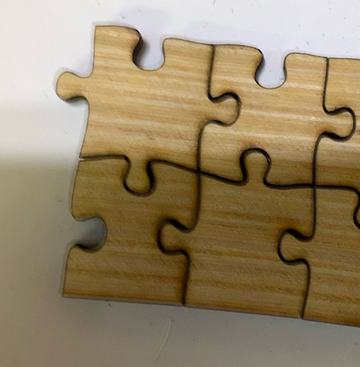
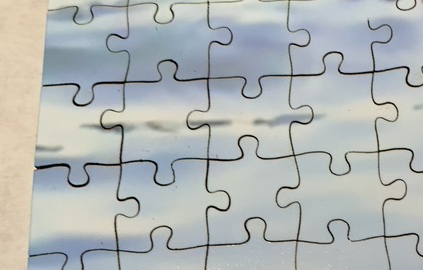
I didn’t measure the kerf with micrometer.
First two photos are of same item kerf 0.0, speed 20mm/sec, Max35%, Min 35%. Air assist 20psi.
2.5" focus D20mm lens, 10mm distance nozzle to substrate.
Third photo different item than first photo. Kerf = 0.075, speed 20mm/sec, Max35%, Min 35%, air assist 20psi. 2.5" focus D20mm lens, 10mm distance nozzle to substrate.
Sorry, images are not the same resolution.
Can you share the .lbrn file?
I’m guessing that the kerf isn’t actually being applied anywhere other than possibly the outer border.
LightBurn file in computer in my shop, will get it later.
This is a stretch… Would the 0.075 kerf setting make the cut more vertical than the 0.0 kerf? If that had any affect it may make the cut appear smaller.
Let’s try another set of facts relative to puzzles. If you laser cut a puzzle, with pieces touching pieces in the design, each puzzle piece’s size will be smaller by half the kerf of that line. Real puzzles are made with cutting dies that push fairly sharp dies into the “board” actually causing the board to burst along the edges of the cuts. This method takes very little away from each piece. Back to lasering puzzles- you mentioned in another post that you laser puzzles on wood. The lens you use has a lot to do with the kerf. Longer lenses may cut thicker wood, but they also have thicker beams and thus have wider kerfs. I do puzzles on a photo mount board. I use a 1.5" lens with a very small kerf, I don’t do anything to allow for that and get a pretty tight fit of the pieces. You also ask about a “vertical cut.” The cut tends to widen under what you cut, it is the nature of lenses to diverge after the focal point, Does that help?
Here is a video that shows what the beam focus and diverging of the beam do: The Basics Of Focus - YouTube
